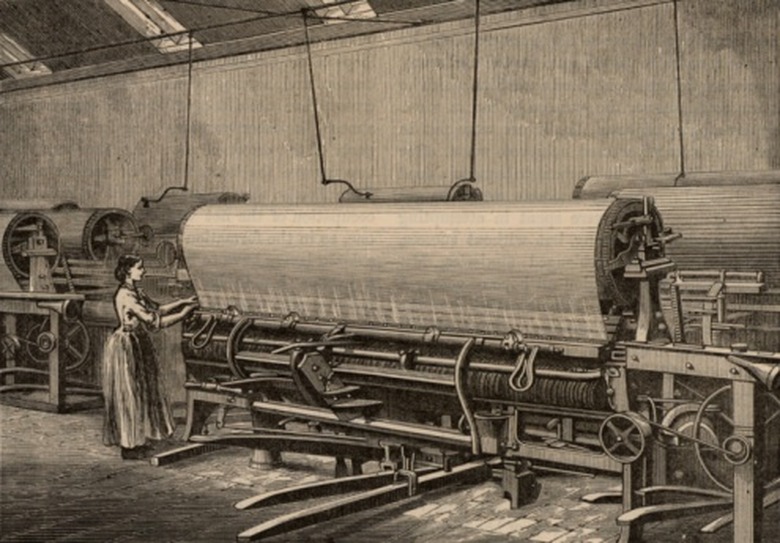Description Of A Flying Shuttle
When you think of a flying shuttle machine, you probably imagine some kind of aircraft. In fact, you may even picture an official NASA Space Shuttle, a major project of the United States' official space program than operated for about 30 years and ended in 2010.
As much of an innovation as that craft may have seemed, the flying shuttle of present concern was arguably an even more significant technological innovation, especially considering how critical weaving and the textile industry were throughout the world from before the Industrial Revolution began until well after its effects resonated around the globe.
Textiles and the Beginnings of Automation
Textiles and the Beginnings of Automation
Before the mid-1700s, throughout the world, most fabrics that were woven (i.e, textiles) were not purchased in the markets of the day but were instead made by hand in the home. By the 1730s, wily inventors had begun producing machines that could produce woven fabrics at a greatly increased rate, signaling the dawn of the age of mass production.
One of these inventions was the flying shuttle. This device was the 1733 creation of John Kay, described as a humble and previously unknown weaver from Essex. (When you think about it, there was probably no previous way for any weaver to be widely known, for the reasons described above.)
By the time of the nineteenth-century Industrial Revolution, numerous improvements had been made on the flying shuttle, leading to the invention of the first automatic sewing machine in 1846.
How Did the Flying Shuttle Revolutionize Weaving?
How Did the Flying Shuttle Revolutionize Weaving?
Before the introduction of the flying shuttle, a handloom weaver had to pass the roll of yarn from one hand to the other in an awkward way to complete a cycle of the weaving process. As simple as it may sound, Kay came up with the idea of a box (the "shuttle") that could be knocked back and forth from one side of the loom to the other in a virtual instant.
Because this saved a significant amount of time with each passing to the other side of the loom, and because these passes add up very quickly, the entire process was immediately speeded up greatly. This allowed for wider production, in turn dropping prices and driving up demand in a positive manufacturing cycle of sorts.
Descendants of the Flying Shuttle
Descendants of the Flying Shuttle
After the release of Kay's invention, a competition was triggered amid enthusiasm over one simple person's ability to effect such a fantastic technological leap forward. Over the next 50 years or so, inventors came up with machines that furthered and disseminated the automation of cloth-weaving.
Among these inventions were the spinning jenny, invented by James Hargreaves in 1764; the water frame (Richard Arkwright, 1769); the spinning mule (Samuel Crompton, 1779); the power loom (Edmund Cartwright, 1785); and the now-famous cotton gin (Eli Whitney, 1792).
- The extraordinary number of patents issued during this period reflected the rate at which technology was improving and being shared among different sectors; weavers would ultimately benefit from seemingly unrelated advances by others and conversely. Before 1760, the government rarely granted more than 12 patents per year, but by 1766, that number had jumped to 31. Seventeen years later it was up to 64, and by the end of the century, it was common for 100 new patents to be issued in a calendar year.
Video Demonstration of the Flying Shuttle Loom
Video Demonstration of the Flying Shuttle Loom
See the Resources for a short video demonstration of the use of a flying shuttle by an experienced professional weaver of fabrics. It is hard to gain an appreciation of the scale by which this invention not only sped up the weaving process back in the day but also took some of the stress off of workers — who still did very difficult work, especially by modern standards!
Cite This Article
MLA
Beck, Kevin. "Description Of A Flying Shuttle" sciencing.com, https://www.sciencing.com/description-of-a-flying-shuttle-12556508/. 16 February 2020.
APA
Beck, Kevin. (2020, February 16). Description Of A Flying Shuttle. sciencing.com. Retrieved from https://www.sciencing.com/description-of-a-flying-shuttle-12556508/
Chicago
Beck, Kevin. Description Of A Flying Shuttle last modified August 30, 2022. https://www.sciencing.com/description-of-a-flying-shuttle-12556508/
